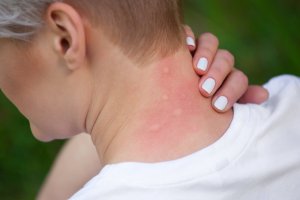Fenistil: A Great Remedy for Stings, Burns, and Hives

Skin care is essential at any time of the year. However, it’s especially important on sunny and hot days to protect from bug bites, sunburns, and allergic reactions. Fenistil is a great topical medication for all of these conditions.
Fenistil is the brand of topical gel. The active ingredient in this gel is dimetindene maleate. This component belongs to the antihistamines group and is used to treat itching that is associated with allergic reactions, superficial burns, and insect bites.
This article will explore this medication and just how it works.
How does Fenistil Work?
Fenistil is a topical gel used to sooth itching caused by irritated skin. It has local anesthetic effects that calm the itchiness caused by allergies, stings, or burns.
Adults and children over the age of one can use Fenistil. Therefore, it’s the perfect medication to have on-hand for any outdoor activities or vacations.
Contraindications
However, some people are allergic to dimetindene maleate or other ingredients found in the gel. Therefore, make sure to check the ingredient list and do not use it on anyone who is allergic to any of the ingredients in the gel.
Anyone who is allergic may go into anaphylactic shock, which can be life threatening. You should also avoid prolonged exposure to the sun on any treated area and do not use on any area of the skin that has open wounds.
Women who are pregnant or breast-feeding should consult a pharmacist or doctor before using Fenistil.
Next, we will explain the following aspects of Fenistil in this article:
- How it works
- Pharmacokinetics
- Side effects
With that said, before we can delve further into each of those points, we must first fully understand histamine, which is a substance found in our bodies that is directly related to this medicine.
Discover: Relieve Flea Bites with 5 Home Remedies

What is Histamine?
The cells of the body synthesize the histamine molecule. It belongs to the group of biogenic amines. These are molecules generated by biological agents.
A biochemical reaction called decarboxylation produces them. This reaction occurs in a molecule called histidine by the enzyme L-histidine decarboxylase.
In addition, bacteria in our intestinal flora and also in food that we eat produce this enzyme. Therefore, they are able to synthesize histidine.
Overall, histamine is involved in the local responses of the immune system. In addition, it aids in regulation of normal gastric functioning and neuro-transmission system of the central nervous system.
Essentially, the functions of histamine include:
- Allergies: Histamine intervenes in immediate hypersensitivity reactions and allergic reactions. Therefore, it directly affects both the humoral and cellular immune responses. In addition, it acts as the primary mediator for immediate hypersensitivity reactions.
- Neurotransmitter: Histamine can act as a neuromodulator, modulating or regulating responses to other neurotransmitters.
- Cardiovascular regulation: This substance is a vasodilator because of its interaction of the H1 and H2 receptors that are distributed in all resistance arteries and in almost all vascular beds. This function is very important to understand the effectiveness of Fenistil.
- Extravascular smooth muscle: It produces contractions of the smooth muscles.
- Gastric juices: This molecule helps to promote secretion of gastric juices and triggers abundant excretion of acids by the parietal cells.
Also read: 5 Remedies to Calm Insect Bite Allergies
How Does Fenistil Work?
Dimetindene maleate, the active ingredient of Fenistil, acts by interacting conversely with the H1 receptors of histamine. By blocking the binding of histamine to H1 receptors reduces the vascular hyper-permeability associated with immediate hypersensitivity reactions.
At low concentrations, it stimulates the histamine methyltransferase that deactivates the histamine. Additionally, dimetindene maleate also has anesthetic properties when applied topically.
Pharmacokinetics and Side Effects
Fenistil gel quickly penetrates the skin and releases its antihistamine effects within a few minutes. Then, the effect reaches its maximum after 1-4 hours. After topical application, the absorption of dimethindene maleate is approximately 10% of the applied dose.
Adverse reactions can occur from this medicine. However, they’re usually very mild and only occur where the medicine was applied.
That said, some side effects include:
- Dry skin.
- Burning sensation of the skin.
- Allergic dermatitis.
Have you ever heard about this topical medication? If you have any questions or concerns, you should ask a pharmacist or doctor.
Remember that you should use it with caution to avoid any adverse reactions.
All cited sources were thoroughly reviewed by our team to ensure their quality, reliability, currency, and validity. The bibliography of this article was considered reliable and of academic or scientific accuracy.
- Ficha técnica de Fenistil, Agencia Española de Medicamentos y Productos Sanitarios. Disponible en: https://cima.aemps.es//cima/dochtml/ft/54083/FichaTecnica_54083.html
- Fenistil. GlaxoSmithKline. Disponible en: https://www.fenistil.es/
- Escartín, R., Acín Lázaro, M. P., Bono, C., Rodrigo, M. D., Quero, J., & Cía, P. (2007). Buprenorphine local tolerability after the prophylactic administration of antihistamine H1 antagonists. Revista de La Sociedad Espanola Del Dolor.
- Baroody, F. M., & Naclerio, R. M. (2000). Antiallergic effects of H1-receptor antagonists. Allergy. https://doi.org/10.1034/j.1398-9995.2000.00803.x
This text is provided for informational purposes only and does not replace consultation with a professional. If in doubt, consult your specialist.








